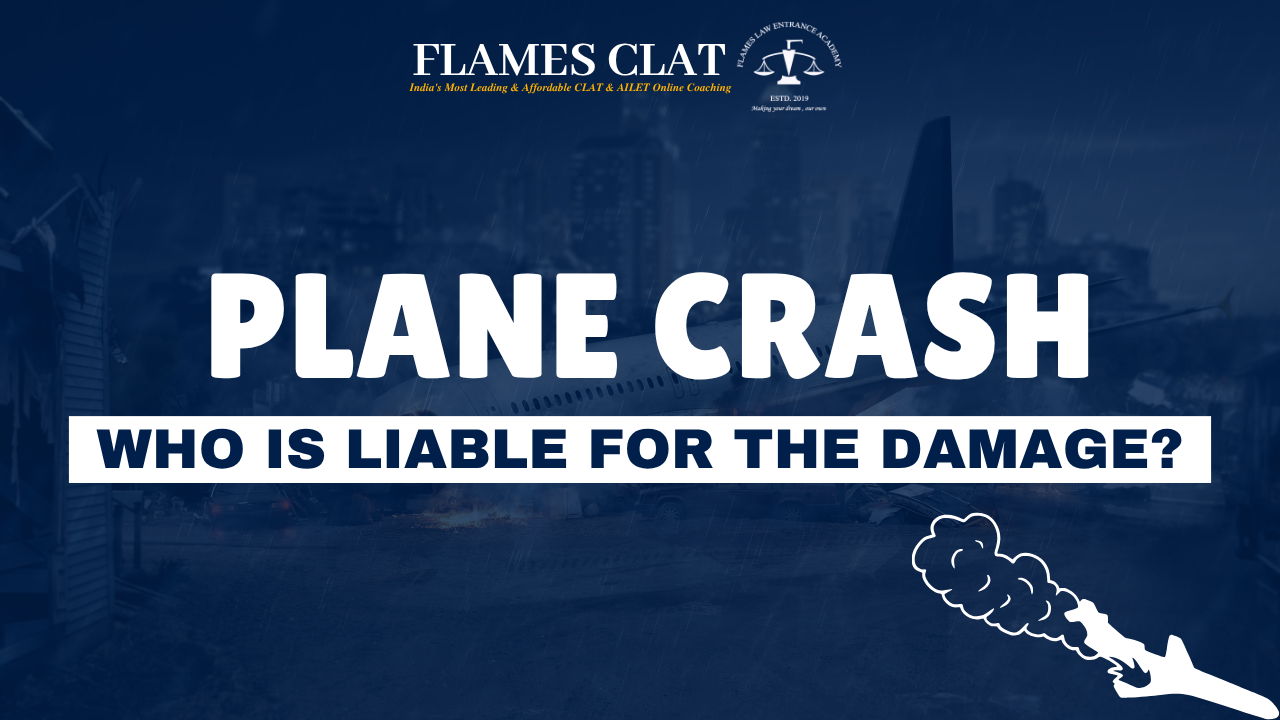Plane Crash: Who is liable for the damage?
The recent Air India Boeing 787 Dreamliner crash near Ahmedabad, causing more than 240 fatalities, has raised various concerns about who will be held liable for the damage that occurred and who will decide the compensation. At Flames CLAT Academy, where future legal professionals are trained to think critically and interpret evolving laws, such provisions of social importance are frequently debated in classes and workshops to nurture legal minds. This blog aims to explore the concept of strict liability in terms of the recent airplane crash and the current aviation laws.
Strict Liability
Strict liability under Tort law is a no-fault liability. It means that a person will be held liable for damage if a hazardous substance possessed by him escapes and causes harm to the plaintiff, even when he did not intend to. This concept was laid down in the Rylands v. Fletcher Case (1868).
Essentials for establishing strict liability are:
- Hazardous Substance – The defendant must possess a dangerous substance on his premises.
- Non-Natural use of land – The use of land where this dangerous substance is kept must be non-natural, meaning it should not be a common practice or a usual business.
- Escape – This hazardous substance must escape from the land of the defendant.
- Damage – It should cause damage to the plaintiff. If there’s no damage, there will be no liability.
There are a few exceptions to this, unlike absolute liability, including acts of God, consent of the plaintiff, statutory authority, and acts of a stranger.
Liability in the Aviation Sector
With ever-increasing tourism, the aviation sector plays a crucial role in bringing the world closer together. In less time, people can now travel around the world. The aviation sector, however, is filled with intricacies of technical operations. It includes aircraft, airlines, operators, and regulatory authorities like the Directorate General of Civil Aviation etc. There are multiple people involved at various levels. Therefore, strict liability is established in case of any mishap. This alleviates the process of giving compensation to the victims.
International regulations to establish this liability:
- Montreal Convention (1999)
This treaty holds airlines liable in case of injury or death to the passengers. It also includes the damage, delay caused, or loss of baggage to the passenger. India is a signatory to this convention, and thus, Air India will be held liable to pay for the damages to the passengers.
- Rome Convention (1952)
It holds aircraft operators liable, ensuring adequate compensation for those who suffer damage or loss due to foreign aircraft.
- Chicago Convention (1944)
Officially known as the Convention on International Civil Aviation. It established a framework for state responsibility towards aviation oversight. However, it does not address the strict liability concept.
Laws governing the aviation sector in India are the Aircraft Act, 1934, and the Aircraft Rules 1937. It is not necessary to prove the fault of the airlines to get compensation for the loss.
Liability of Airlines and Aircraft Operators
Owing to the extensive operations of the flights, the aircraft operators need to take a high level of care. Thereby, making them liable to compensate the passengers in case of any loss due to a crash or the falling of objects from the aircraft.
The dangers of airline travel cannot be foreseen. At various instances, flights have disappeared, been hijacked, bombed, crashed, and shot down. Therefore, certain types of aviation insurance are made mandatory in India. Aircraft operators must maintain aviation insurance to compensate the victims for damage.
Government and military are usually not liable. But some countries have laws making them liable and some governments voluntarily offer compensation to victims.
Relevant precedents
The strict liability in the aviation sector is shaped by various conventions and legal precedents. Some of these precedents are discussed below:
- Pan Am Flight 103
The aircraft exploded due to a terrorist bombing. It underlined that the airline could be held liable for security failure in this case.
- Tenerife Airport Disaster
Due to miscommunication between pilots, two Boeing 747s collided, resulting in more than 500 fatalities. This case highlighted the need for strict liability and improvement in air traffic measures.
- India 2018
An ice block fell on a house in Haryana from an aircraft. The airline was held liable for the damage, applying the strict liability rule.
- Deep Vein Thrombosis case 2005
Injuries from DVT were not caused by accident, thus not attracting strict liability.
Conclusion
The airline and aircraft operator are held liable for any damage or loss caused by the aircraft. This liability has evolved with various precedents and rules. Legal educators at Flames CLAT Academy continue to emphasize such discussions as essential for aspirants preparing for CLAT and judiciary exams, where understanding legal provisions and concepts is not just an academic goal but a tool for real-world impact.
Join our Flames CLAT Family at https://t.me/flamesclat
For Informative videos, do check out https://youtube.com/@flamesclat?si=-PqiaRLEjutM-iYj




Write a Review
Your email address will not be published. Required fields are marked *